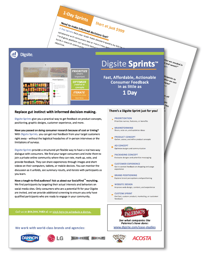Technology has changed the way we go to market with products and services. It has also expanded our options for gathering market data. However, it has not necessarily made it easier to uncover insights that impact marketer’s decisions, especially given tighter time frames and budgets. Iterative Insights codifies a set of practices that more and more marketers are using to address these challenges. If your company is pushing for innovative research methods to quickly deliver insightful research at a low cost, Iterative Insights is what you are looking for.

Iterative Insights was developed by Digsite to solidify a set of best practices that help teams get from idea to market faster. It is an evolution of time consuming and expensive approaches like in-person interviews and online communities. Iterative Insights can be achieved in ways not imagined by these methods, finally breaking through the barrier of faster, better and more affordable research! So what are the key aspects of Iterative Insights and how can you use them to propel your business?
1. Iterative Insights involves multiple consumer touchpoints.
Rather than conducting one-shot research and then waiting for results, Iterative Insights proposes marketers engage in a two-way conversation with a highly targeted group of consumers over a period of days or more. These multiple consumer touchpoints allow you to understand current experiences, brainstorm solutions, and optimize product, positioning or communication concepts. This gives marketers real-time input to make better, more informed decisions, earlier in the development cycle.
2. Iterative Insights demands behavior-based targeting.
One of the most important aspects of Iterative Insights is that your participants have enough knowledge of the problem being solved to be the right audience to provide solutions and give value for your research. This means identifying people based on their interests in certain brands or activities, and behaviors related to your solution. Unfortunately, approaches we have relied on for decades (such as large national panel companies), have become less reliable with robots and/or fakers who reduce the validity of research we collect. The great news on this front is that social media sites like Facebook collect and aggregate consumer data in real time and can be used micro-target the right person, in the right place, at the right moment.
3. Iterative Insights requires collaborative engagement.
Moving toward Iterative Insights is also important because it allows marketers to get rapid, rich data from real conversations. Rather than one-on-one discussions or survey questions, Iterative Insights lets participants have free-flowing dialog in a natural social-media style setting, often seeing each other’s answers and building on them. Businesses can ask follow-up questions both of individuals and the group, evolve and adjust the discussion over days, and rapidly adapt to refine marketing, brand, or product ideas based on real-time feedback. This approach helps to strengthen your understanding and empathy for customers because they participate in the process rather than remaining at arm’s length.
Iterative Insights help fill the gaps of quantitative research methods – we help you understand what your customers are thinking. Qualitative research answers the “why’s” that result from online market research. Iterative Insights allows you to deepen and extend your reach with your target audiences to truly understand what your customers want. Richer, more frequent feedback from smaller groups of the right people is the way to go.
4. Iterative Insights emphasizes in-context learning.
When I started as a market researcher in 1995, the concept of in-context (or ethnographic) research was just beginning to disrupt the industry. Since then, we have learned that when we ask people to do things in their own environment, we get better and more honest answers. And to the extent that we can observe behaviors in person or on-video, we’re able to identify latent or unarticulated needs. Iterative Insights embraces this philosophy in a new device-central world, where the majority of shopping is occurring online and where people capture their real-world behaviors every day on mobile devices.
I have seen a massive change in the quality of insights we receive simply by engaging people on a platform that acts like the social media sites they use every day. They share more detail, are more honest and emotive in their responses, and they feel empowered because their voice is instantly heard by others and responded to rather than going into a vacuum.
5. Iterative Insights focuses on rapid decision making.
Many existing approaches to engaging consumers don’t align well with the rapid decision making that needs to go in-tandem with Iterative Insights. Interpreting findings from existing data or conducting surveys often doesn’t provide enough context or customer collaboration to provide specific direction. Conducting focus groups or other in-person research may not be practical because of the cost and timeframe, or would need to be repeated multiple times in order to adjust and respond to feedback. And traditional online communities are typically very expensive to setup and maintain, making them cost prohibitive for smaller brands or organizations with a diverse product portfolio.
However, newer technologies for Iterative Insights are designed to align with lean teams and agile research approaches because they automate many of the logistical challenges of traditional market research. Look for insights platforms that offer device-agnostic interfaces, allow two-way conversations, and have the ability to reengage participants, as well as embedded tools for efficiency such as standardized templates, automated recruiting and reminders, and quick and easy analysis and reporting tools.
You see the fit for Iterative Insights for your marketing challenges. Now what?
I would like to propose that we strive to move beyond collecting insights one at a time from large pools of people who aren’t our target consumers, and begin to rethink how we conduct market research to better help drive your business forward. In the coming months I'll be sharing more of my thoughts around Iterative Insights and why this practice is so critical to the success of your organization. Please subscribe to this blog, share your thoughts and pass this along to your colleagues.
To learn more about how your company can benefit from Iterative Insights, check out our Digsite Sprints Fact Sheet!





